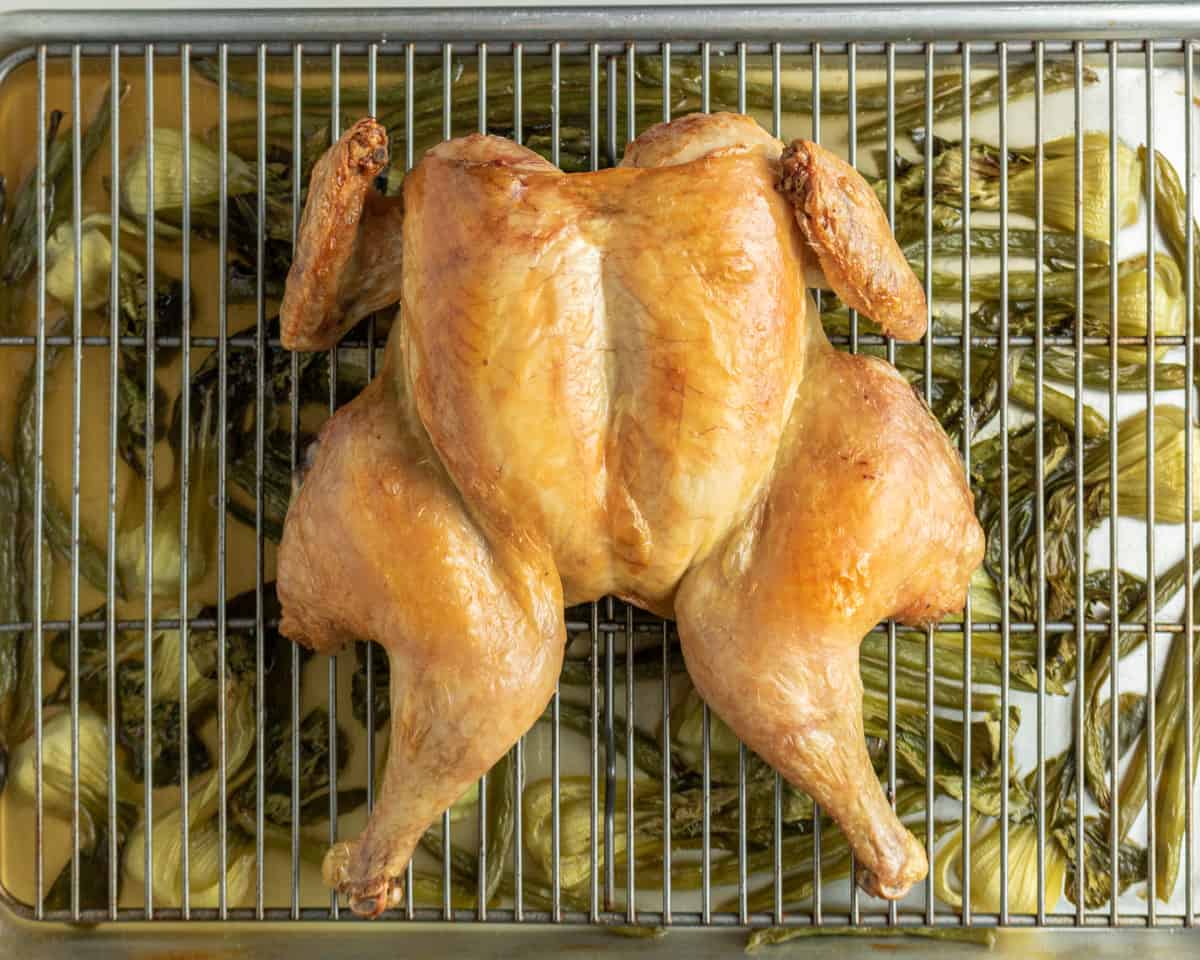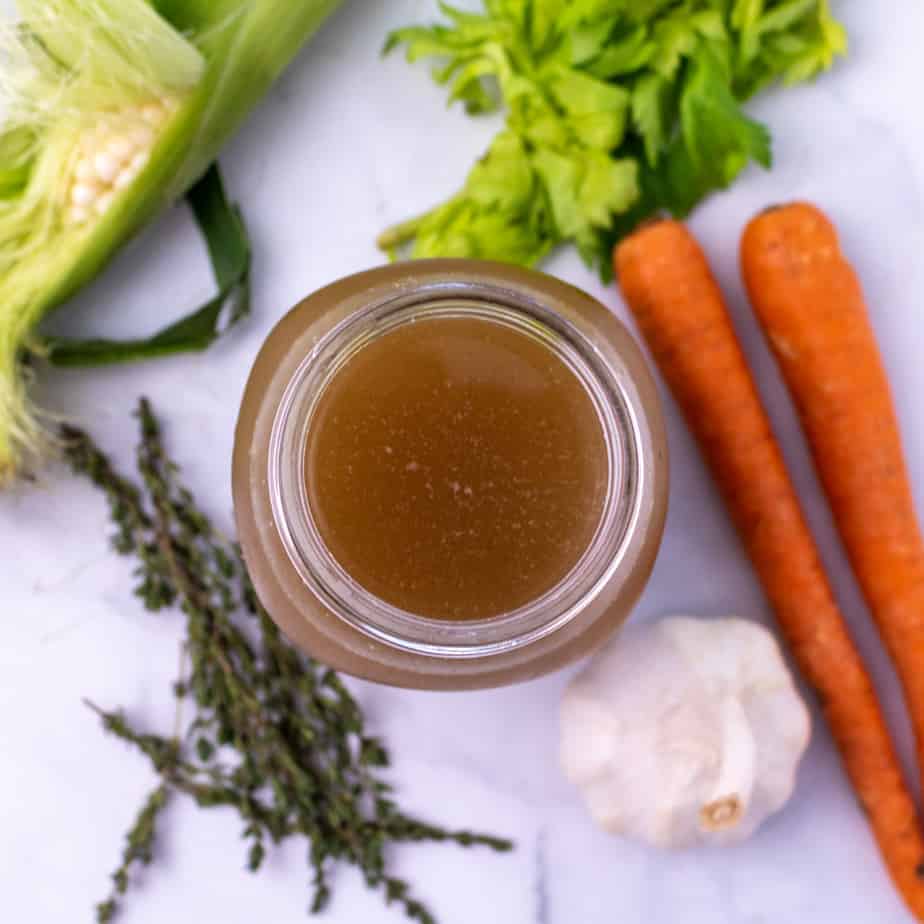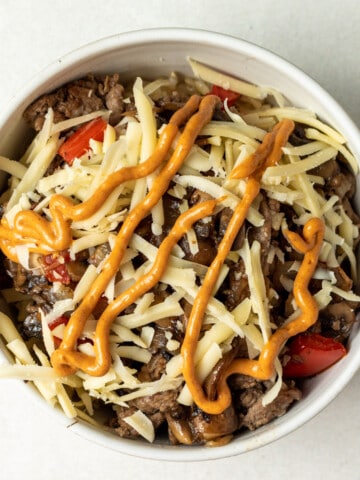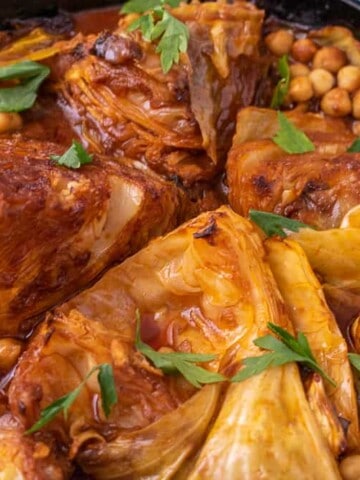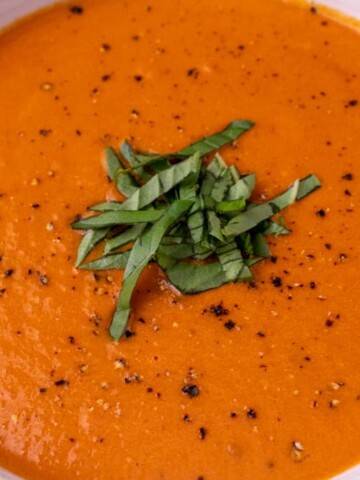Making homemade chicken stock is a great way to reduce food waste. Using leftover roasted chicken bones/chicken carcass to make a stove top chicken stock is a cheap way to use up what you already have. Add in carrots, onions, celery, fresh herbs and simmer on the stove in a dutch oven or stock pot to make your house smell amazing. Use the homemade, low sodium chicken stock in your favorite soup or sauces.
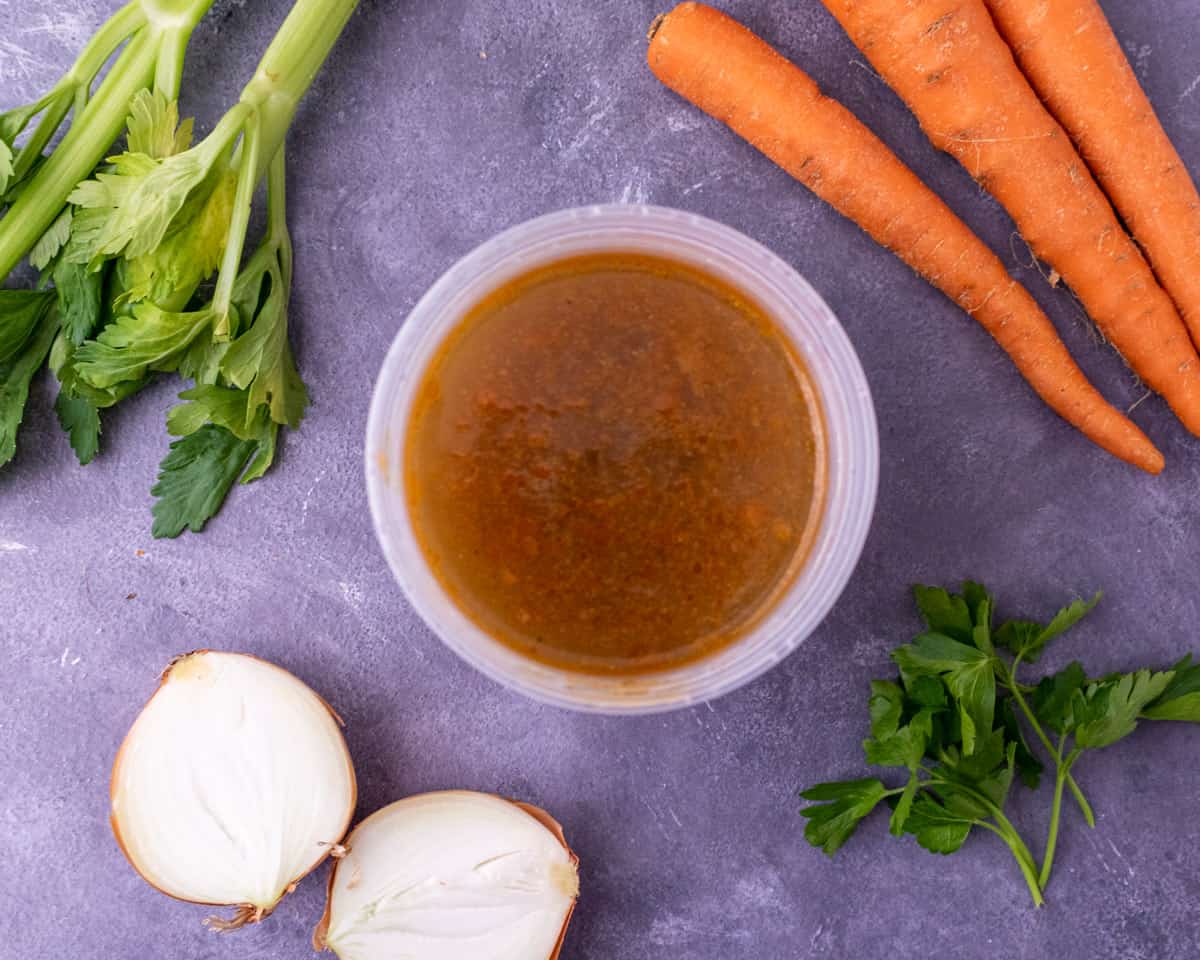
Jump to:
Tips and Tricks
What can you do with chicken stock? Chicken stock is a flavorful liquid that can be used in a variety of recipes. Use homemade chicken stock to make chicken noodle soup, creamy tomato bisque or a pan sauce gravy.
Other options are to use it to cook rice or pasta. Chicken stock will never go to waste, it’s always a great way to add flavor instead of using water.
What to do with chicken stock leftovers? If you make a recipe and have leftover chicken stock, the best thing to do is to freeze it. I recommend freezing the stock in usable portions like one cup or in ice cube trays. This will allow it to be used in the future easily and not take forever to thaw.
How do you store homemade chicken stock? You can store chicken stock in the fridge for up to five days or in the freezer for up to six months.
Store in airtight containers but allow room for expansion in the freezer. It is best to store chicken stock in a plastic or freezer safe container; glass can crack easily while defrosting.
How do you store leftover chicken carcass? If you made a spatchcock chicken, make sure you save the backbone and wing tips in a large ziploc bag or airtight container. After you roast your chicken, save any chicken juices from the pan and put in an airtight container.
Pick off any of the meat you want for leftovers and store separately. Now, add all the bones into the ziploc with the raw chicken pieces. If you’re making stock in the next few days, store in the fridge.
If not, store in the freezer for up to six months. Optionally, you can add the vegetables and herbs you want to use to that same ziplock in the freezer.
What’s the difference between chicken stock, chicken broth and chicken bone broth? There are small differences between all of these. If you’re making a sauce or cooking pasta or rice, any of them will work.
Homemade chicken stock/broth/bone broth will ALWAYS taste better than anything from the store.
Chicken stock is made with bones and cartilage, chicken broth is made from meat and chicken bone broth is basically stock that has been simmered for 24-48 hours. The best option for soups is chicken stock or bone broth because they have better flavor and mouthfeel.
How many cups does this recipe make? Depending on a few different factors, you can expect to get four to six cups of chicken stock from this recipe. It all depends on how large your dutch oven is (I use a six quart) and how long you let it simmer and at what temperature.
How long can you keep chicken bones for stock? You can store chicken bones in the freezer for at least up to six months. I only store chicken bones in the fridge for two days, otherwise I freeze them.
Why does my chicken stock look like jello? This is exactly what you’re looking for! Once chicken stock has cooled, the consistency should be closer to jello due to the collagen from the bones (and specifically the backbone you saved!). It will turn to liquid as you heat it and will make for a great soup base!
Why is my chicken stock bland? If your chicken stock smells really good but doesn’t have a ton of flavor (it shouldn’t taste like soup straight from being simmered) it probably needs salt and to be seasoned. If using it for soup, be sure to season it well with salt until it tastes good but not salty.
Ingredients

- Canola oil - any neutral oil will work
- Chicken carcass - including backbone and wing tips
- Carrots - chopped into large chunks, not peeled
- Celery - chopped into large chunks
- Onion - yellow or white onion works here, skin on
- Head of garlic - cut in half exposing the bulbs, skin on
- Thyme - fresh or frozen
- Parsley - fresh or frozen
- Black peppercorns - whole peppercorns
- Parmesan rind - optional
- Leftover chicken juices - optional, these are the juices from the sheet pan after roasting
See recipe card for quantities.
Do you need to use fresh aromatics? You can freeze carrots, celery, onions and herbs with the chicken bones and just put those directly into stock from frozen. Often, if I have leftovers or stuff about to turn, I toss it in a bag in the freezer for stock. It reduces food waste!
Are these measurements exact? Definitely not exact. If you have four medium carrots that will work just as well as three large carrots. Part of it is preference and part of it is what you have to work with.
You can even leave out some of these things like the chicken juices, black pepper or parmesan rinds and still get a great stock. This recipe is a basic recipe for inspiration to help you elevate your cooking with flavor.
Method
How do you make stock from leftover roasted chicken? Preheat a dutch oven over medium heat. Chop carrots and celery into rough thirds and quarter the onion. Next, chop the garlic head completely in half to expose the cloves but leave skin and peel intact.
In the dutch oven, add the canola oil. If your chicken is defrosted, sear the backbone, wingtips and extra skin until you get some color. If your chicken is frozen, add the whole carcass to the dutch oven.
Add in carrots, celery, onions, garlic, fresh thyme, parsley, peppercorns, parm rind and chicken juices (if using). Cover with 8-10 cups of water (the water should just be covering the ingredients but be ½ - 1 inch below the rim.
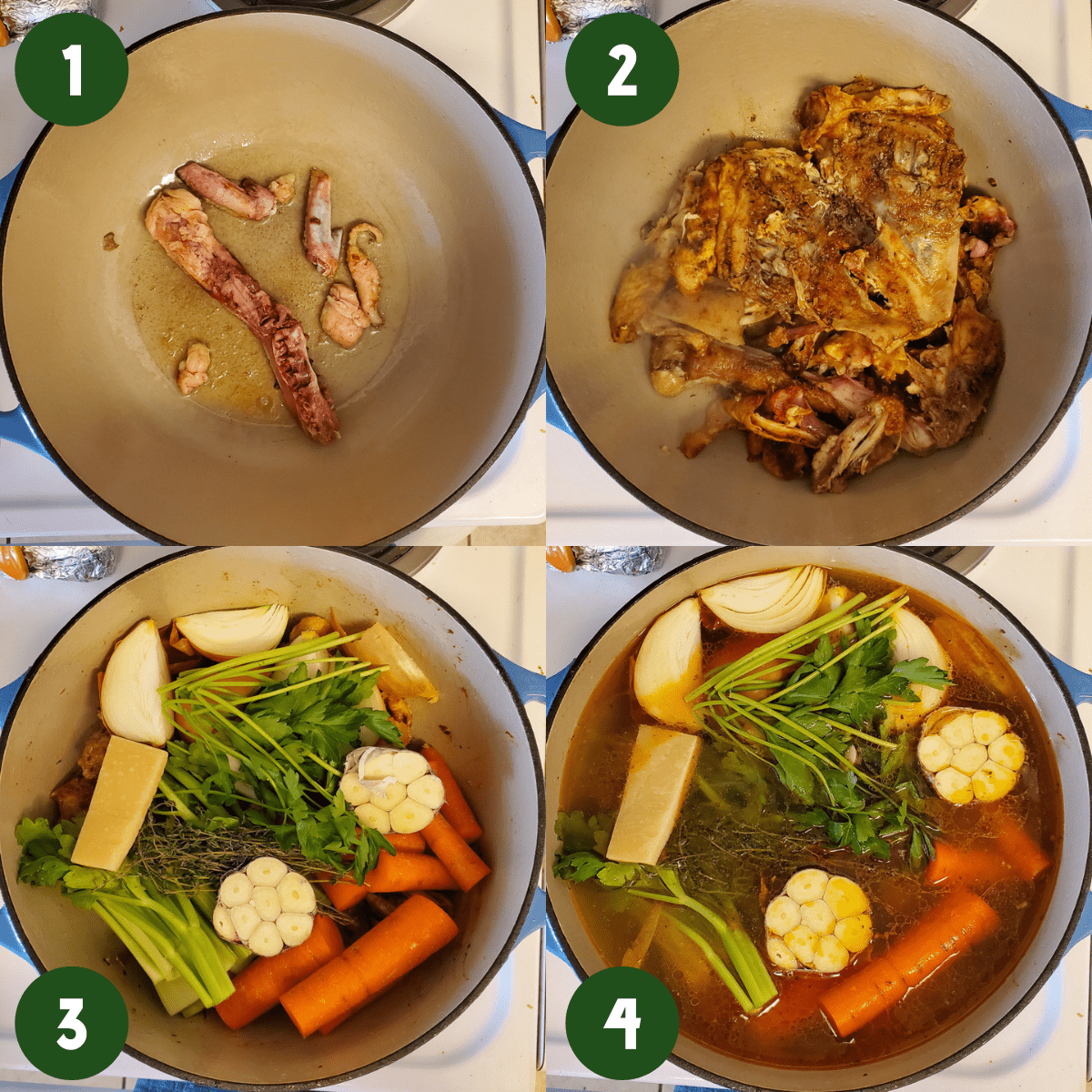
Increase the heat to a medium high to bring it to a low boil. Once it comes to a boil reduce to a simmer (medium low to low heat). After one hour, skim any impurities off and allow to simmer for three more hours.
After four total hours of simmering, carefully remove large solids. Strain liquid into another pot or large metal mixing bowl through cheesecloth (affiliate link) or a fine mesh strainer (affiliate link). Discard any solids.
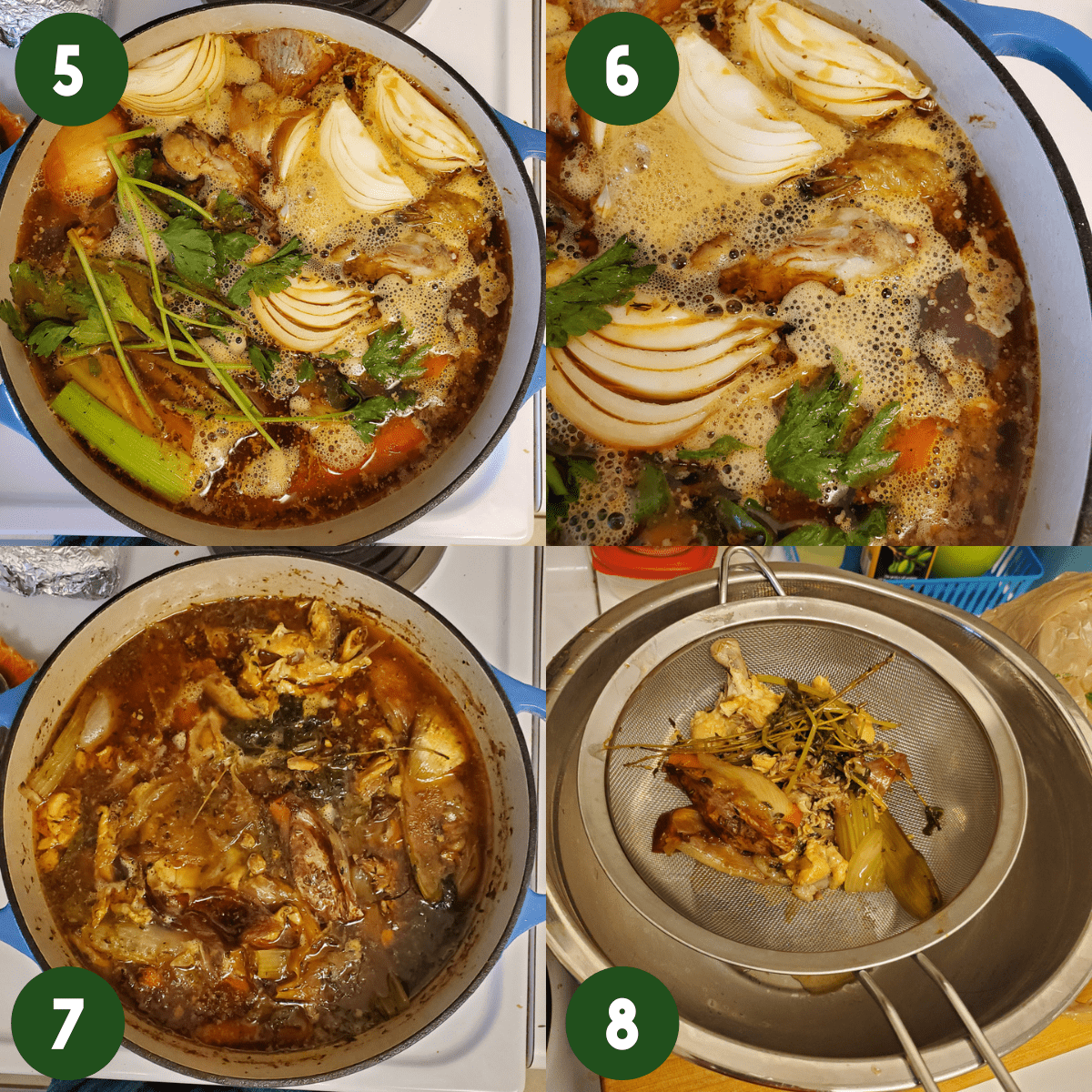
Cool stock in the bowl in an ice bath or in the sink surrounded by ice. (Don’t do this in a glass bowl) Once chilled, remove fat that rises to the top and then portion out into containers.

If freezing, leave room for expansion. Store in the fridge or freezer.
Do you peel the onions, carrots and garlic? Nope! Everything gets strained out. There is a lot of flavor in the peel and skin of aromatics.
How long do you let the stock cook? Let the stock simmer for about four hours but you can go longer. If you let it go longer than four hours, it will have a deeper flavor but the water will reduce, leaving a more concentrated but less volume stock.
When do you add salt? I don’t add salt until I go to use the stock in a recipe. In some recipes like rice, you’re reducing the water completely so if you over salt, your end product could be salty. It is harder to take away the salt without the end product becoming too watery.
Hint: Don't salt the stock until you’re using it in the final recipe to avoid over salting.
Substitutions
What aromatics can you substitute? You can use a range of different things to flavor your stock like leeks, scallions, shallots, corn cobs, ginger, sage, rosemary, cilantro, mushrooms or bay leaf. I’d avoid anything from the cabbage and broccoli family, brassica, because it can turn a stock bitter.
Variations
All of the stocks/broths I make at home are a variation of this one with different main ingredients.
- Corn stock uses leftover corn cobs from the summer
- Vegetable stock
- Beef bone broth
Equipment
Any large stock pot (affiliate link) or dutch oven will work for this recipe. The dutch oven (affiliate link) I use a 6qt and it just fits everything.
Top Tip
Store the chicken carcass in the freezer after you pick off all the meat. This allows you to make stock whenever you’re running low or in the mood for soup. You can freeze the aromatics as well to always have the ingredients on hand.
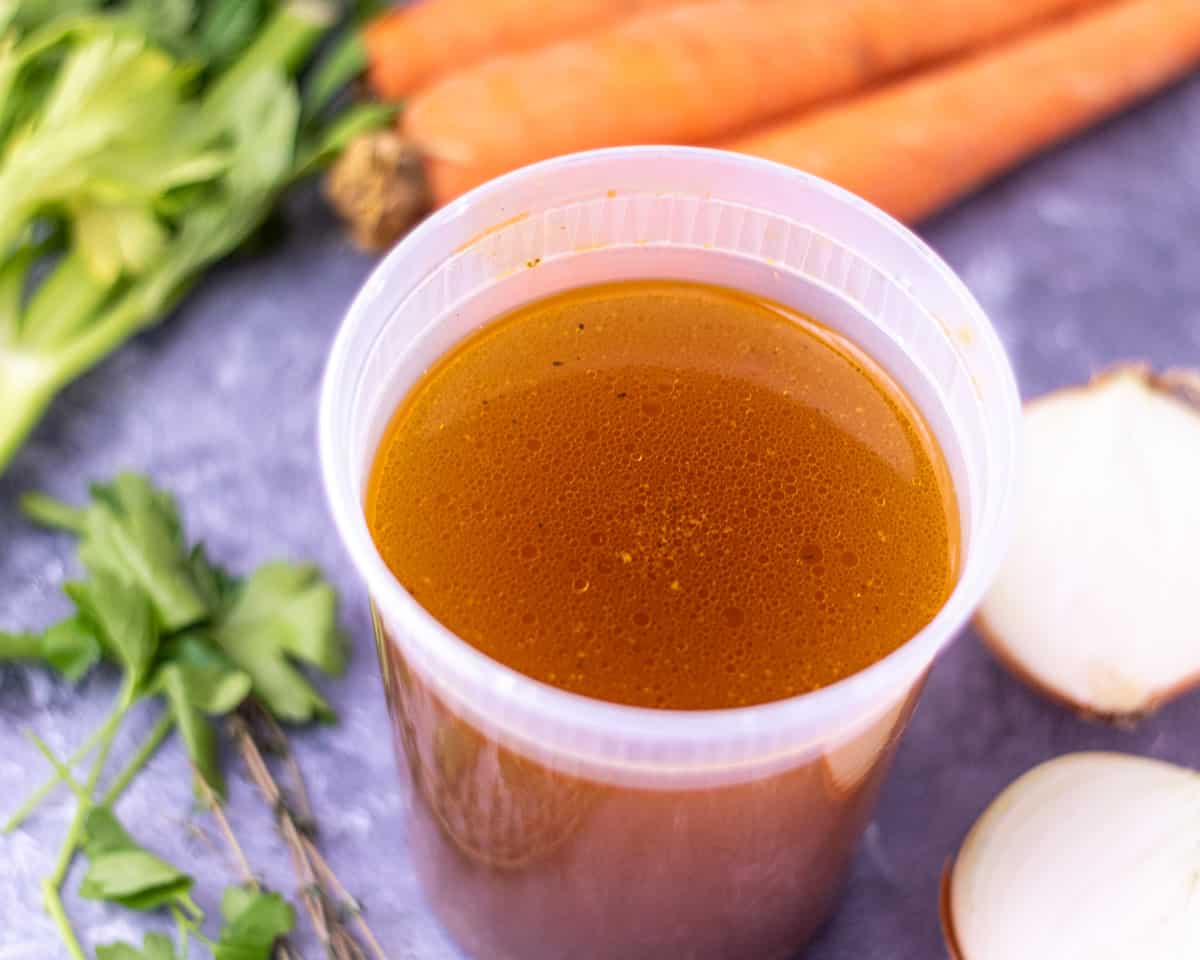

Leftover Homemade Chicken Stock
Ingredients
- 2 tablespoons canola oil
- 1 leftover roasted chicken carcass including backbone and wing tips (from 3-4 lb chicken)
- 3 large carrots
- 3-4 ribs celery
- 1 large yellow onion skin on
- 1 head garlic skin on, cut in half
- 5-6 sprigs fresh thyme
- 5-6 sprigs fresh parsley
- 4 whole black peppercorns
- Parmesan rind optional
- Leftover chicken juices optional
- 8-10 cups water
Instructions
- Preheat an at least 6 quart dutch oven or stock pot over medium heat.
- While preheating, chop carrots and celery into rough thirds and quarter the onion. Chop garlic head completely in half to expose the cloves. Leave skin and peel intact.
- Add the canola oil once the dutch oven is preheated. If your chicken parts aren’t frozen, sear off the backbone, any leftover skin and wingtips until they get some color on them, they smell like roasted chicken and the skin is crispier. If the chicken parts are frozen, just add the whole thing into the pot and proceed to the next step.
- After the backbone is seared and golden brown, add in carrots, celery, onions, garlic, fresh thyme, parsley, peppercorns, parmesan rind and chicken juices (if using).
- Cover with 8-10 cups of water. The water should just be covering the ingredients but be ½ - 1 inch below the rim.
- Increase the heat to a medium high to bring it to a low boil. Once it comes to a boil reduce to a simmer (medium low to low heat). You want to see small bubbles that are gently breaking the surface while simmering.
- After 1 hour, skim any impurities off if desired and allow to simmer for 3 more hours uncovered. Skimming off the impurities allows for a clear chicken stock, but if that doesn’t matter to you, skip to the next step.
- After 4 total hours, carefully remove large solids. Strain liquid into another pot or large heat proof metal mixing bowl through cheesecloth or a fine mesh strainer. Discard any solids.
- Cool stock in the bowl or pot in an ice bath or in the sink surrounded by ice. Do not chill hot soup in a glass bowl, it will crack once it hits the ice. Once chilled, remove fat that rises to the top and then portion out into containers. If freezing, leave room for expansion.
Notes and Accommodations
- Measurements are all guidelines minimum, you can always add more of anything.
- Use on their way out or slightly bruised aromatics and herbs, they’ll work great.
- Chicken stock should slightly solidify like jello after being cooled.
- Skim fat off chicken stock once cooled.
- Store chicken stock in the fridge for up to 5 days in an airtight container or up to 6 months in the freezer in a plastic container to avoid cracking.
- Leave room in the container if you are freezing to account for expansion.
Original recipe posted on September 6, 2020. Updated tips and tricks along with clearer instructions on April 18, 2022.
Food Safety
- Cook to a minimum temperature of 165 °F (74°C)
- Do not use the same utensils on cooked food, that previously touched raw meat
- Wash hands after touching raw meat
- Don't leave food sitting out at room temperature for extended periods
- Never leave cooking food unattended
- Use oils with high smoking point to avoid harmful compounds
- Always have good ventilation when using a gas stove


